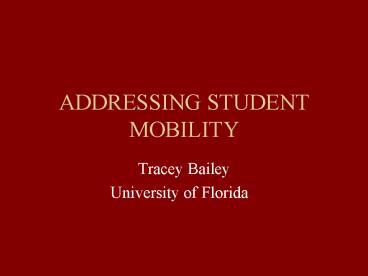ADDRESSING STUDENT MOBILITY - PowerPoint PPT Presentation
Title:
ADDRESSING STUDENT MOBILITY
Description:
ADDRESSING STUDENT MOBILITY Tracey Bailey University of Florida ADDRESSING STUDENT MOBILITY Tracey Bailey University of Florida Who s impacted by student mobility? – PowerPoint PPT presentation
Number of Views:78
Avg rating:3.0/5.0
Title: ADDRESSING STUDENT MOBILITY
1
ADDRESSING STUDENT MOBILITY
- Tracey Bailey
- University of Florida
2
- Whos impacted by student mobility?
- Students
- Those who move away
- Those left behind
- Teachers
- Unexpected new arrivals
- - space
- - placement
- Short notice departures
- - closure
- Schools
- Funding based on numbers
- Challenge of tracking students records
- Financial loss of withdrawals
3
- Mobile Populations
- Based on his examination of the 1988 National
Health Interview Survey Long found that children
who had moved an above-average number of times
(the top 20 percent of movers, controlling for
the childrens ages) over their lifetimes were - - less likely to be living with both parents,
- - more likely to be poor, and
- - more likely to be in households whose heads
were unemployed or did not graduate from high
school - (Tucker, Marx, Long, 1998, p.115).
4
- Behavioral Characteristics
- Warning signs that a child is not adjusting well
to the move - long-term anxiety
- depression
- significant disruptions in sleep
- poor socialization
- falling grades
- SAMHSAs National Mental Health Information
Center ( 9)
5
- Behavioral Characteristics
- Rebellious
- Resentful
- Angry
- Hurt
- Confused
- Lost
- network of friends social support
- parents may be less available
- different school curriculum
6
How do schools measure mobility?
7
Terminology mobility rate is the rate at
which students move into or out of the school
population during the school year, shown as a
percentage. It is calculated by dividing (a) the
total number of new entries, reentries, and
withdrawals during the 180-day school year by (b)
the total number of students who were enrolled at
the start of the school year (Florida School
Indicators Report, 23). stability rate on the
other hand is the percentage of students from
October membership count who are still present in
the second semester (February count)
(Florida School Indicators Report, 28).
8
Find Out What Mobility Looks Like In Your
School The Florida Department of Education
website makes it easy to examine rates of
mobility as well as stability for individual
Alachua county schools of all three levels -
elementary, middle, and high school. These rates
can then be compared with those of schools in
other Florida counties.
9
Counseling Strategies To be used with new
incoming students - Buddy systems -
Orientation - Consultation To be used with
departing students - Momentos - Integrating
move into class curriculum - Class discussion -
Going away party
10
- Recommendations
- welcoming program in schools
- follow-up sessions with new students
- universal curriculum
- electronic network of student records
- support for parents/family of new arrivals
- more studies on mobility of children
11
References Addressing Barriers to Learning (UCLA
SMHP Newsletter). Easing the Impact of Student
Mobility Welcoming Social Support.
Retrieved January 25, 2004 from
http//smhp.psych.ucla.edu/easimp.htm Cornille,
T.A., Bayer, A.E., Smyth, C.K. (1983). Schools
and Newcomers A National Survey of Innovative
Programs. Personnel Guidance Journal, 62(4),
p. 229-236. Division of Teaching and Learning
website (May 14, 2003). Student Mobility.
Retrieved January 24, 2004 from
http//www.tand.leon.k12.fl.us/programme/mobilit
y.html Fisher, T.A., Matthews, L., Stafford,
M.E., Nakagawa, K., Durante, K. (2002).
School Personnels Perceptions of Effective
Programs for Working with Mobile Students and
Families. The Elementary School Journal,
102(4). 317-333. Florida Department of
Education website (n.d). Florida Indicators
Report. Retrieved January 24, 2004
from http//info.doe.state.fl.us/fsir2002/school_
report.cfm
12
Florida Department of Education website (n.d).
Florida Indicators Report (Indicator
Descriptions). Retrieved January 24, 2004
from http//info.doe.state.fl.us/fsir2002/indicat
or_desc.cfm Rumberger, R.W. (2003). The Causes
and Consequences of Student Mobility. Journal
of Negro Education, 72(1), p. 6-21. SAMHSAs
National Mental Health Information Center website
(n.d). Your Childs Mental Health Moving
Easing the Transition. Retrieved January 25,
2004 from http//www.mentalhealth.org/publications
/allpubs/Ca-0046/default.asp Simpson, G.A.,
Fowler, M.G. (1993). Geographic Mobility and
Childrens Emotional/Behavioral Adjustment and
School Functioning. Pediatrics, 93(2)
303-309. Tucker, C.J., Marx, J., Long, L.
(1998). Moving On Residential Mobility and
Childrens School Lives. Sociology of Education,
71,(April) 111-129. University of Michigan
Health System (n.d). Children and Family
Moves. Retrieved on January 25, 2004 from
http//www.med.umich.edu/llibr/pa/pa_kidsmove_aa
c.htm
13
Wood, D., Halfon, N., Scarlata, D., Newacheck,
P., Nessim, S. (1993). Impact of Family
Relocation on Childrens Growth, Development,
School Function, and Behavior. JAMA, 270(11),
1334-1338.































